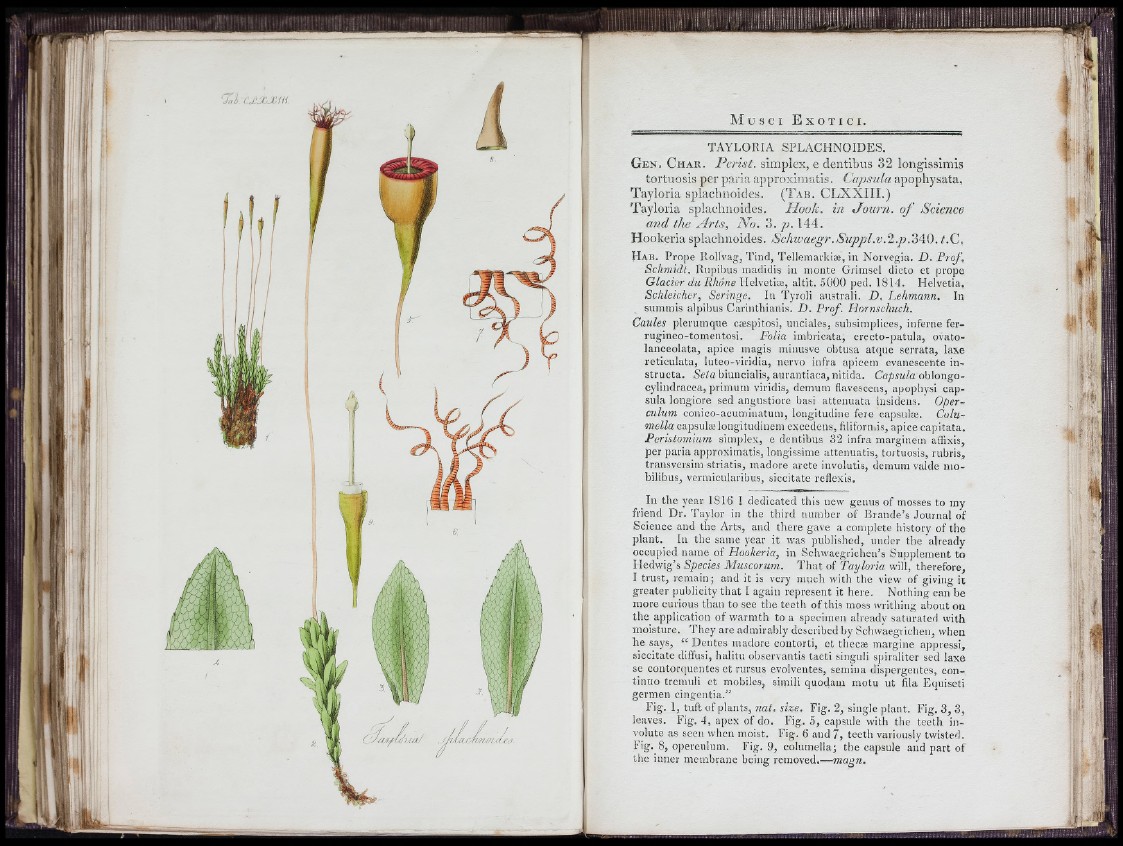
J ;
TJj r .x x ju n .
TAYLORIA SPLACHNOIDES.
G e n . C h a r . Perist. simplex, e dentibus 32 longissimis
tortuosis per paria approximatis. Capsula apophysata,
Tayloria splaclmoides. (Tab. CLXXIII.)
Tayloria splaclmoides. Hook, in Journ. o f Science
and the A rts, iV o. 3. p . 144.
Hookeria splaclmoides. Schwaegr.Suppl.v.^i.p.2>4i). t.C,
Hab. Prope Rollvag, Tind, Tellemarkiæ, in Norvegia. D. Prof.
Schmidt. Rupibus inadidis in monte Grimsel dicto et prope
Glacier du Rhone Helvetia;, altit. 5000 ped. 1814. Helvetia.
Schleicher, Seringe. In Tyroli australi. D. Lehmann. In
summis alpibus Carinthianis. D. Prof. Hornschuch.
Caules plerumque cæspitosi, unciales, subsimplices, inferne ferrugineo
tomentosi. Folia imbricata, erecto-patula, ovato-
lanceolata, apice magis minusve obtusa atque serrata, laxe
reticulata, luteo-viridia, nervo infra apicem evanescente instructa.
Sela biuncialis, aurantiaca, nitida. Capsula oblongo-
cylindracea, primum viridis, demum flavescens, apophysi capsula
longiore sed angustiore basi attenuata insideus. Operculum
conico-acuminatum, longitudine fere capsulæ. Columella
capsulæ longitudinem excedens, filiforniis, apice capitata.
Peristomium simplex, e dentibus 32 infra marginem aflixis,
per paria approximatis, longissime attenuatis, tortuosis, rubris,
transversim striatis, madore arcte involutis, demum valde mo-
bilibus, vermicularibus, siccitate reflexis.
In the year 1816 1 dedicated this new genus of mosses to rny
friend Dr. Taylor in the third number of Braude’s .Journal of
Science and the Arts, and there gave a complete history of the
plant. In the same year it was published, under the already
occupied name of Hookeria, in Schwaegricheii’s Supplement to
Hedwig’s Species Muscorum. That of Tayloria will, therefore,
I trust, remain; and it is very much with the view of giving it
greater publicity that I again represent it here. Nothing can be
more curious than to see the teeth of this moss writhing about on
the application of warmth to a specimen already saturated with
moisture. They are admirably described by Schwaegrichen, when
he says, “ Dentes madore contorti, et thecæ margine appressi,
siccitate diffusi, halitu observantis taeti singuli spir.iliter sed laxe
se contorquentes et rursus evolventes, semina dis))ergentes, continuo
tremuli et mobiles, simili quodani motu ut fila Equiseti
germen cingeiitia.”
Fig. 1, tuft of plants, nat. size. Fig. 2, single plant. Fig. 3, 3,
leaves. Fig. 4, apex of do. Fig. 5, capsule with the teeth involute
as seen when moist. Fig. 6 and 7, teeth variously twisted.
Fig. 8, operculum. Fig. 9, columella; the capsule and part of
the inner membrane being removed.—magn.
k:L
I n